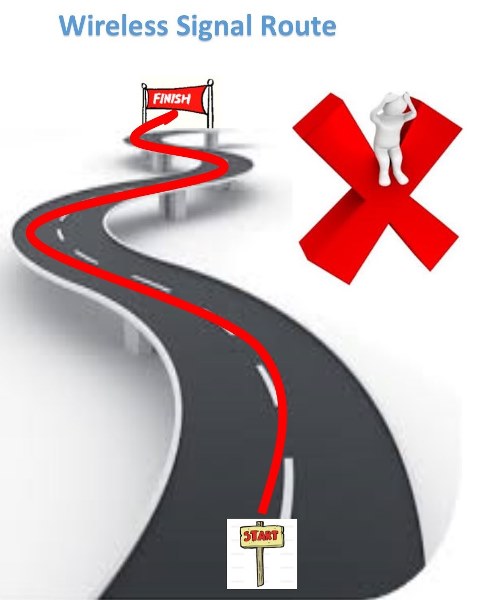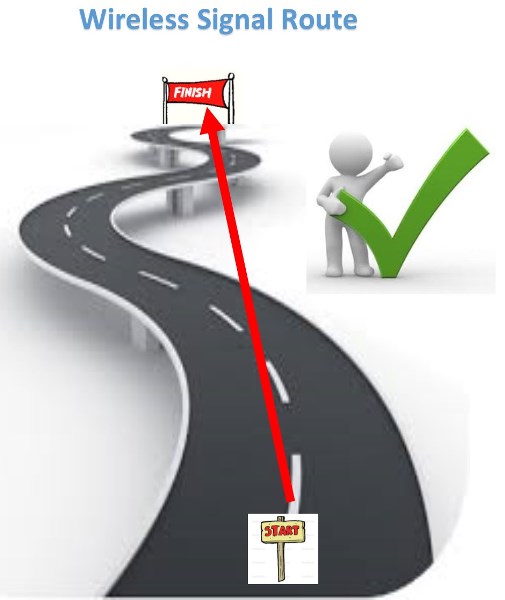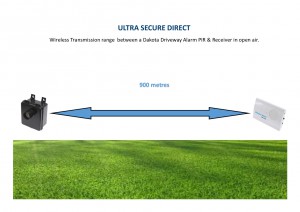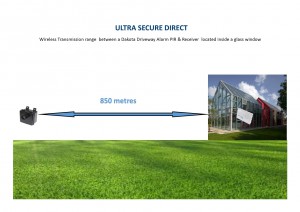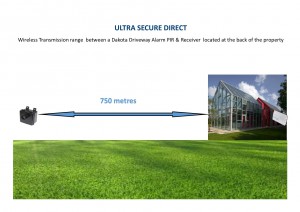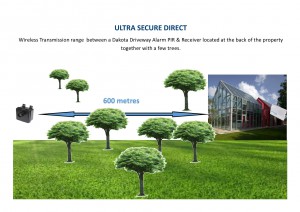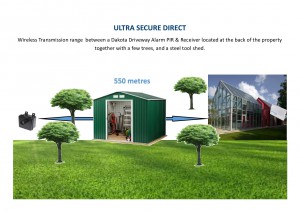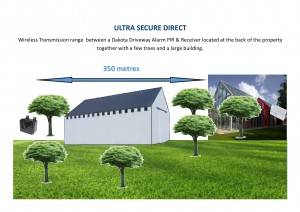The term ‘Line of Sight’ means that a Wireless Signal has been tested in open air, normally in optimum conditions for the transmission distance to be measured between two devices, commonly seen when purchasing Wireless Alarms.
This term is commonly used in the Security Industry when discussing various forms of Wireless Equipment including:
- Driveway Alarms
- Perimeter Alarms
- House Alarms
- Doorbells
- Intercoms
- CCTV
Although this could be seen as slightly misleading, unfortunately it is the industry standard and no manufacturer is going to change when all of their competitors are doing the same, therefore we just need to understand the principle and make more informed decisions whilst making a purchase.
The Route of a Wireless Signal:
Before we get into the ‘Line of Sight’ discussion, there is a basic principle which is sometimes misunderstood, the actual route the Signal will attempt to take is ‘Direct’, please see the two diagrams below:
The above example of the route of a Wireless Signal is incorrect, please see the diagram below showing a more realistic route that the signal will attempt to take.
The diagram above shows the realistic route that a Wireless Signal will follow between a Transmitter and Receiver.
Line of Sight Principle, for this example we are going to imagine using a Dakota Wireless Driveway Alarm which has an advertised wireless range of 900 metres, but the principle is the same for all Wireless products:
- The Wireless transmission distance advertised between a Sensor and Receiver is 900 metres and is based on a clear line of sight, no obstacles, no hills & good weather, see diagram below:
- In nearly all applications, with the exception of perhaps using an external Pager, the Receiver would always be inside the home or office, therefore for this example will imagine the Receiver is just inside a glass window.
The reduction in transmission range would probably only be 50 metres, depending on the nature of the glass, please see diagram below: - If the Receiver was going to be located at the far side of the house, this may result in two additional partition walls being an additional obstruction, therefore we may loose another 100 metres in wireless transmission range, even more if the house is built of stone, please see diagram below:
- If we then place a few tree’s in between the two locations, we would probably loose another 100 metres in winter and probably 150 metres during the summer months, when the trees are full of leaves, please see diagram below:
- If we then place a single story shed or garage between the two locations, we would probably loose a further 50 metres through wood, 100 metres through thin steel, please see diagram below:
- If we replace the single story shed or garage for a large farm building, we would probably loose between 350 – 400 metres, please see diagram below:
The examples listed above are only approximate, because the possible variations from home to home, business to business are just too numerous to mention, but hopefully it has helped you understand the principle enough to help you make a more informed decision.
Using our past experience we have listed different materials below, and a guide to some possible Wireless Transmission Reductions you may experience:
- Glass = 5 – 10%.
- Plasterboard Partitions = 5 – 10%.
- Brick = 15 – 20%.
- Stone = 25 – 50%.
- Trees during winter = 5 – 10%.
- Trees during summer = 10 – 20%.
- Low Buildings, such as single story garages, tool sheds = 10 – 20%.
- High Buildings, Barns, Workshops = 25 – 50%.
Please Note: You would expect larger reduction in transmission range through obstructions when using products which are transmitting Video such as Wireless CCTV & Wireless Intercoms due to more data being transfered!!
Even when you understand this principle, you can never be 100% sure that the Wireless signal will work in your environment, this is why we at Ultra Secure Direct give our customers the best possible pre-purchase advice and a no quibble 30 day wireless money back guarantee, allowing plenty of time to try the device.
Summary:
So you are about to purchase a Wireless House Alarm, Driveway or Perimeter Alarm or a CCTV System, then we recommend you take notice of the advertised transmission range of any product you are researching, then take into account the proposed location of the transmitters & receivers and the quantity and nature of all obstructions. Then hopefully using the information gleaned from this article, you will feel more comfortable to make a purchase.
Ultra Secure Direct do test the transmission range of every wireless product they advertise, so are in a very good position to give you good honest advice via the Telephone, Email or Live Chat should you want or need some guidance.

